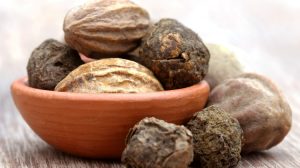8

Triphala
Triphala is an herbal rasayana formula consisting of three fruits – Amalaki, Bibhitaki, and Haritaka. Amalaki, Phyllanthus emblica, which also goes by the names Amla or Indian Gooseberry, produces a sour and fibrous fruit. It supports digestive health, purifies the blood, and rejuvenates the liver.
Bibhitaki, Terminalia bellirica, produces seeds or kernels called bedda nuts. The pulp of the fruit has astringent and laxative qualities. It helps balance the body, strengthens the lungs, and improves immune function.
Haritaki, Terminalia chebula, produces nut-like fruits containing triterpenes, gallic acids, and phenolic compounds. The seeds have long been used in Ayurvedic and Traditional Tibetan medicine for a number of health promoting benefits, including its ability to reduce oxidative stress.
All three fruits are used in equal parts to produce triphala. Triphala has numerous antioxidant properties and immunostimulatory effects on cellular response, particularly cytotoxic T cells and natural killer cells. Both are types of white blood cells that respond rapidly to viral-infected cells and tumor formation.
In short, these special white blood cells kill cancer cells. One of the active ingredients in triphala – chebulinic acid – also has anti-tumor capabilities, making triphala a potent weapon against one of the leading causes of death in the modern world.
Triphala Benefits
One of the benefits of triphala is its potential to aid weight loss. It does this by increasing lean body mass, controlling blood sugar, and by getting rid of excess fat in your cells. Check out this video, as Dr. Oz discusses the fat fighting capabilities of this super fruit with Dr. Kulreet Chaudhary.
On a side note, you’ll notice Dr. Oz grimace after drinking the triphala mix. However, I’ve been consuming greater amounts of triphala mixed alone in water for months, and it’s not that bad. A bit astringent and sour, to be sure, but definitely tolerable.
Triphala benefits the body in a number of ways, including …
- Improving organ function
- Detoxifying the body
- Improving colon and digestive health
- Strengthening the immune system
- Improving nutrient absorption
- Maintaining healthy liver function
- Strengthening the lungs and heart
- Improving the urinary tract
- Stopping the growth of cancer cells
That last one has a lot of folks studying triphala, which means you can easily find clinical trials touting its benefits as a cancer fighter. This 2005 study focused on breast and prostate cancer (two of the more commons cancers) and concluded that triphala showed a significant cytotoxic (toxic to cells) effect on cancer cells.[41] Researchers also state that it suppresses the growth of cancer cells due in large part to the gallic acid content in triphala.
Another study came to the same conclusion, stating that triphala possesses the ability to induce cytotoxicity in tumor cells but spared the healthy cells.[42] And this 2011 study on triphala and gallic acid concluded that “gallic acid appears to have promising anti-cancer activity.“[43]
Triphala’s effect on pancreatic cancer was the focus of this 2008 clinical trial.[44] The results of it showed that triphala is effective at inhibiting the growth of human pancreatic cancer cells. That’s four studies on three different types of cancer and one general conclusion: triphala is a potent cancer fighter.
Another study tested triphala against several bacterial isolates from HIV patients with very positive results, leading researchers to conclude that this Ayurvedic herb is a potent antibacterial.[45] They also reasoned that this is due, in part, to several strong phytochemicals present in triphala, such as flavonoids and carotenoids.
If you watch the video, you’ll hear Dr. Chaudhary say that this is one herb that all of us should include in our diet, and I would have to agree. Which is why I’ve included it in the top 10. But let’s not forget; it’s actually three super herbs in one convenient package!
Triphala Uses
As Dr. Chaudhary states in the video, the powder form of triphala is best, and I concur. It’s the closest you’ll come to finding it in its most natural form. And what’s natural health without the natural.
Also in the video, Dr. Chaudhary mixes triphala together with psyllium husk and ground flax seed. This is an excellent idea for those looking to slim down, as the presence of the psyllium and flax will also aid fat loss. Both contain a ton of fiber and will trick your body into thinking you’re more full than you really are.
If that mix is off-putting in any way, you can try mixing triphala in a glass of warm milk (at least organic and preferably raw) with some freshly squeezed lemon juice and a bit of raw honey. This will undoubtedly taste better. But if you’re time crunched and you simply want the benefits of triphala minus the hassles, just mix it into water and slug it down. Trust me, it’s not that bad.
Lost Empire Herbs has a high quality, low-cost triphala powder that I use and would definitely recommend. You’ll notice on that page some information on how important it is to actually “taste the herb.” However, if you’re extremely opposed to this, you can try an encapsulated triphala powder from Organic India, another company I trust.
